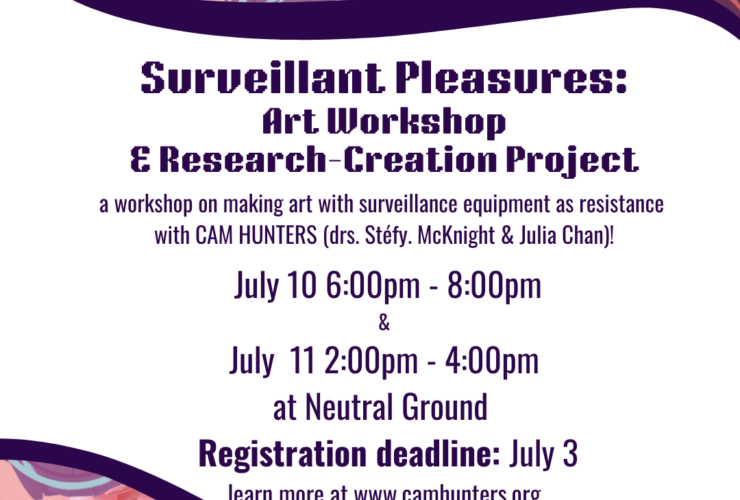contained
Leesa Streifler
September 13 – October 11, 2003
Essay
The 35 photographs in Leesa Streiflers Contained are both simple and complex. Their collective simplicity is established by the insistence on the silhouette with its immediate presentation of icon and image. The complexity derives from an engagement with old and new media, and from an interrogation of the silhouette’s meaning from a subjective point of view. Streifler began her project with the identification of small scale graphic elements. These were coloured in or coloured out, as it were, to form silhouettes, and then they were scanned and digitally enhanced. The pristine silhouettes were overlaid by expressive counterparts, drawings made with stationery supplies: sheets of acetate, felt pen and white correction fluid the tools of absence and presence. The finished works combine the digital and the hand drawn image collapsed into a final form, the single 26 x 32 inch photos and the composite 52 x 64 works all printed digitally using the colour photographic process.
Streifler exploits the recognizable cultural signs of middle-class life in North America: a suburban house, a bunny, and a pin-up girl signs that circulate as part of the complex interchange of commerce, relationships and identity formation. The simplified black silhouettes are already dense grounds of meaning. They remind us of photographys deep history. They invoke conventions of graphic design and advertising. One needs only the barest suggestion of contour, only a glance to recognize these visual clichs. The pre-packaged emotional and cultural grounds are transformed through the intense pressure of Streiflers subjective eye. The seamless impenetrability of the suburban house yields to the intense angst of family, relationships, sex and death, emotional drifts and disorders of all kinds.
Streifler doubles up on all kinds of polarities: black and white photography/the painted image, interior/exterior, surface/depth, and inside/outside. Of the combination of silhouette and drawing, she notes that, themes of privacy and protection (house), vulnerability and sentimentality (rabbit) gender stereotypes (pinup) and desire emerge from these juxtapositions. But its in the intersections and the disjunctures where Streiflers eye, hand and heart are displaced and embodied. There are lots of unusual twists and turns and many of these pairings are at odds with each other. A sweet bunny has a vicious and rabid nature; the pin-up girl has rot-gut kidneys.
Streifler’s photographic work was shown in a retrospective in Toronto at the Photographers Workshop in 1993. She began using photography in 1988 in combination with painting and drawing. Her exhibition at Plug In, Contemporary Mythology (1990), created a dialogue between the mechanical and the emotional, with large scale photographs re-written by expressive mark-making. The subject matter included images of dis-ease, unrest and instability. The photographs and drawings were overlaid with drawings burned into Plexiglas and rubbed with cadmium red oil paint.
Streifler makes her art from a place of intuition and emotion, a process that often moves the imagery away from a perceptual reality to a psychic reality of the embodied self. She explains that, what lies under the surface is more real than whats on top, so the drawings or the expressive elements dig deeper into the psychological, the holistic, the spiritual and the political. Her show at the Mackenzie Art Gallery, In Extremis (1992), included photographs of scientific inquiry the hospital, the natural history museum, the taxidermy shop and the zoo. These photographic studies of human and animal bodies, each dyed a separate, jewel-like colour, overwhelmed the viewer through their large scale and dramatic colouring. The use of a single colour with its analytical exploration of its subjective meaning has been used again in Contained.
Other bodies of earlier work by Streifler have informed Streiflers exploration of subjectivity. In Normal, curated by Vera Lemecha for the Dunlop Art Gallery in 1997, Streifler created 67 Adaptations and 35 Acts. She photographed herself and altered her image and identity by overlaying the portraits with drawings and textual fragments. The artist inhabits various identities with humour, self-mockery and pathos only to find these positions ill-fitting and strange. The small framed photographs, which were exhibited on shelves, offered up a series of potential subjectivities and narrative contexts. The work traveled to Dazibao in Montreal in 1998, Latitude 53 in Edmonton in 1999, the Beaverbrook Art Gallery in Fredericton in 2002 and the Propeller Centre for the Visual Arts in Toronto in 2002.
During her residency at Open Studio in Toronto in 2001, Streifler exploited the thematic direction suggested by Normal. She created and exhibited a suite of screen prints called Freakshow Revisited: the Giant and the Bearded Lady. In Contained, her visual research into the exploration of the intersection of the individual and the social continues.
– Amy Karlinsky is a free-lance art critic based in Winnipeg.
Leesa Streifler is Professor of Visual Art at the University of Regina. She received her MFA from Hunter College in New York. She lives and works in Regina, Saskatchewan. Her work is included in public and private collections including the Canada Council Art Bank, Canadian Museum of Contemporary Photography, Saskatchewan Arts Board, Mackenzie Art Gallery, Winnipeg Art Gallery, the University of Saskatchewan, City of Regina, City of Winnipeg.
The artist wishes to thank the Saskatchewan Arts Board and the University of Regina Faculty of Fine Arts for their generous support.



